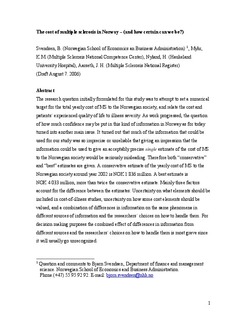| dc.contributor.author | Svendsen, Bjørn | |
| dc.contributor.author | Myhr, Kjell-Morten | |
| dc.contributor.author | Nyland, Harald Inge | |
| dc.contributor.author | Aarseth, Jan Harald | |
| dc.date.accessioned | 2007-06-21T12:03:13Z | |
| dc.date.available | 2007-06-21T12:03:13Z | |
| dc.date.issued | 2006-08 | |
| dc.identifier.issn | 1500-4066 | |
| dc.identifier.uri | http://hdl.handle.net/11250/163879 | |
| dc.description.abstract | The research question initially formulated for this study was to attempt to set a numerical target for the total yearly cost of MS to the Norwegian society, and relate the cost and patients´ experienced quality of life to illness severity. As work progressed, the question of how much confidence may be put in this kind of information in Norway as for today turned into another main issue. It turned out that much of the information that could be used for our study was so imprecise or unreliable that giving an impression that the information could be used to give an acceptably precise single estimate of the cost of MS to the Norwegian society would be seriously misleading. Therefore both “conservative” and “best” estimates are given. A conservative estimate of the yearly cost of MS to the Norwegian society around year 2002 is NOK 1 836 million. A best estimate is NOK 4 033 million, more than twice the conservative estimate. Mainly three factors account for the difference between the estimates: Uncertainty on what elements should be included in cost-of-illness studies, uncertainty on how some cost elements should be valued, and a combination of differences in information on the same phenomena in different sources of information and the researchers´ choices on how to handle them. For decision making purposes the combined effect of differences in information from different sources and the researchers´ choices on how to handle them is most grave since it will usually go unrecognized.
When related to illness severity, the total cost per patient to society seem to increase, and the patients experienced quality of life to decrease, in a close to linear fashion with increasing EDSS-levels 1. However, a warning should be raised that because of the uncertainties as those mentioned, Norway probably has a long way to go before studies like ours in general might be regarded as providing acceptable information for decisions as important as those that have to be made in the health sector.
1 The EDSS, Kurtzke`s “Expanded Disability Status Scale”, is the most common tool used to express illness severity in MS. The scale ranges from 0 (no disability) to 10 (dead due to MS) and is divided in 20 half-point steps. | en |
| dc.language.iso | eng | en |
| dc.publisher | Norwegian School of Economics and Business Administration. Department of Finance and Management Science | en |
| dc.relation.ispartofseries | Discussion paper | en |
| dc.relation.ispartofseries | 2006:12 | en |
| dc.title | The cost of multiple sclerosis in Norway – (and how certain can we be?) | en |
| dc.type | Working paper | en |
| dc.subject.nsi | VDP::Samfunnsvitenskap: 200::Økonomi: 210::Samfunnsøkonomi: 212 | en |
| dc.subject.nsi | VDP::Medisinske Fag: 700::Klinisk medisinske fag: 750::Nevrologi: 752 | en |
